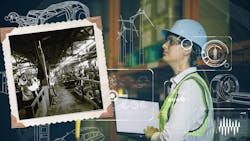Machines behave according to the laws of physics. The planet operates according to the laws of nature. Those laws are finite and uncompromising. Humans have their own set of laws, and while some of those also depend on physics and nature, most others are left to the inconsistencies of the people who apply them.
And in times of chaos and uncertainty—and these times certainly qualify—we often seek large solutions and grand gestures to alleviate those concerns and quell the crisis. It might be helpful to look at these times in terms of a manufacturing plant to see the way forward.
The plant is not, in fact, a single entity. It is a collection of systems and machines and individual operators. There are common goals, but only when each of the individual pieces work together as a seamless unit does the plant achieve its full potential. When one part breaks down or when one line doesn’t operate efficiently, the impact is felt everywhere. And if leadership isn’t tuned into the needs of each of the parts, the whole cannot succeed.
But there are all kinds of leadership in a plant. The top-down management style can work, but only if there is a full understanding of how each of the individual pieces work together, and if there is empathy for the workers at the bottom of the organizational chart. And middle-out management also is effective, but only if the goals for the upper management and the line workers both are realized.
Bottom-up management isn’t a management style at all. It’s what we call personal responsibility. If each worker takes full responsibility for performing tasks at the highest level, the entire organization cannot help but succeed.
It’s one thing to make an argument for personal responsibility against the geopolitical background we face today, but we too often apply that standard to others. There are certain things out of our individual control. If we manage our work and our family and ourselves with commitment and integrity, we will have done all we can right now to affect change.
But we have a term in manufacturing for that: It’s called “continuous improvement.” We need to embrace that idea to help us make ourselves, and each system we work on, just a little better every day.
About the Author
Bob Vavra
Senior Content Director, Power & Motion and Machine Design
Bob Vavra is the Senior Content Director of Power & Motion and its sister publication Machine Design. Vavra has had a long career in publishing, media and events. He has covered all aspects of manufacturing for the past 20 years and is a regular attendee at events such as IMTS and Hannover Messe. Vavra is also a sought-after webcast moderator and event emcee, and has presided over events in the U.S., Germany and China.

Leaders relevant to this article:
